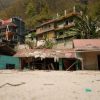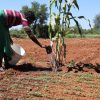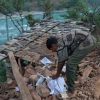Writer and Web page data
- This web page: https://www.globalissues.org/article/805/cop20-lima-climate-conference.
- To print all data (e.g. expanded aspect notes, exhibits various hyperlinks), use the print model:
On this web page:
Introduction
 December 1 – 14, 2014, Lima, Peru was the venue for the twentieth annual United Nations Local weather Change Convention, also called the twentieth Convention of the Events — or COP 20.
December 1 – 14, 2014, Lima, Peru was the venue for the twentieth annual United Nations Local weather Change Convention, also called the twentieth Convention of the Events — or COP 20.
The aim of this convention was to create a common settlement on local weather change motion and start the method of financing mitigation.
Assembly consequence
The assembly ended with all nations agreeing to chop again greenhouse fuel emissions. Often called the Lima Accord, this treaty isn’t legally binding and international locations don’t have to specify how a lot they may in the reduction of, as an alternative agreeing to report their plans again by March 2015.
Whereas for a lot of it gave the impression of a profitable consequence, others have been dissatisfied, resembling poor international locations struggling to rebuild from present impacts of local weather change who have been alarmed on the disappearance of loss and harm commitments from the ultimate textual content which has been a part of the dialogue for years.
The worldwide local weather motion, 350.org, summarized the disappointments and hopeful facets of the assembly consequence, noting
- The brand new settlement doesn’t mirror the urgency of the local weather disaster
- Some good agreements – however no measures to make sure implementation
- Least developed and susceptible nations overlooked within the chilly
- Divestment (from fossil gasoline reliance) is extra necessary than ever
- International momentum for actual options is stronger than ever and can carry on going.
In attempting to place a constructive spin on the general disappointment they felt, they concluded, In the long run, a worldwide local weather treaty is only one software to fight local weather change. Actual change goes to proceed to return from the grassroots. The UN Local weather Talks proceed to be a spot the place the world’s international locations comes collectively to debate this disaster and individuals are placing in monumental efforts to verify Paris [the next global meeting] received’t be like Copenhagen
which was stuffed with disappointments regardless of huge guarantees.
Samantha Smith, Chief of WWF’s International Local weather and Vitality Initiative, was fairly scathing of the assembly consequence saying that political expediency received over scientific urgency
. She additionally famous that Developed nation governments couldn’t even handle to clarify how they may ship the long-promised US$100 billion per yr in local weather finance by 2020. In a transfer that seemingly dismissed the plight of probably the most susceptible international locations, they fully eliminated any significant language about ‘loss and harm’.
Mainstream media reporting
As with nearly each earlier assembly (with occasional exceptions), mainstream media reporting was very poor given the significance of this world concern. The place the assembly was reported it was usually in direction of the tip, and simply sound chew kind summaries saying all international locations agreed to emission cuts and that this was a significant enchancment.
Whereas the treaty continued to say it honors the long-standing frequent however differentiated tasks
the mainstream media reporting (as in most years) has usually failed to supply rationalization and context of this precept that has been an necessary a part of these talks for over 2 a long time; that poor and creating international locations shouldn’t bear the identical tasks because the developed ones (as a result of they don’t seem to be the reason for the anthropogenic carbon emissions over the earlier a long time which have led to this, which is detailed way more on this web site’s web page on local weather justice).
A touch in direction of this precept could have been introduced as a viewpoint of China or India, given the impression they’re being obstacles, reasonably then explaining this precept in additional context.
That was simply one of many points skirted over or omitted from frequent reporting. Others included points on financing, expertise assist for poorer nations, and many others. Behind the scenes, for many years, wealthy international locations have stalled on this stuff or actively prevented attempting to share expertise and many others, which is barely reported.
Yearly, this criticism is manufactured from mainstream reporting, so with out following these negotiations annually, it may be simple to return away with the impression that this assembly had a constructive consequence.
However as this dialogue hosted by Democracy Now! exhibits, there have been quite a few necessary problems with competition:
In context: frequent however differentiated tasks
A few years in the past all nations agreed that local weather change was largely the results of actions from at the moment’s industrialized nations, as carbon dioxide — the principle greenhouse fuel — stays within the ambiance for many years. But, the poorest would find yourself struggling probably the most for an issue they largely didn’t trigger. The approaches to mitigation (emissions discount) would subsequently be totally different for these teams of nations — the frequent however differentiated tasks precept.
It’s on this context that the dialogue for loss and harm has come about. And it’s one thing that wealthy international locations are eager to eliminate .
The years of resistance on this concern (and plenty of others) means every time it’s mentioned once more the reactions appear to get much more hostile. Mixed with the shortage of detailed context within the mainstream media protection of this side, it then turns into simpler every time to see culprits as China and India given their monumental greenhouse emissions lately, in comparison with the far better quantity by the industrialized nations over the longer interval. See this web site’s part on local weather justice for extra detailed background.
And as this web site has mentioned for years on the local weather justice web page, the wealthy nations are delaying any significant motion till it’s finally — and disproportionately — paid for the by the creating nations. New Delhi primarily based Nitin Sethi, affiliate editor at Enterprise Normal, interviewed within the earlier talked about video says the identical factor, however extra frankly:
There isn’t a motion that’s going to occur between now and 2020. All of that was to be finished by the developed international locations. They [rich nations] mainly have simply mentioned at Lima that
we aren’t going to do any greater than what we’re doing to this point, and the burden can shift onto the post-2020 period, the place different creating international locations need to share it.So, to me, it signifies actually negotiation in dangerous religion.
Extra data
Because the convention remains to be underway as this web page is written, extra data will probably be added right here after the occasion is over.
For extra concerning the points from different organizations, listed below are some beginning factors:
Information tales from IPS
Under is an inventory of tales from Inter Press Service associated to the Lima local weather convention and its aftermath.
-
Bringing the World’s Meals Manufacturing in Line with International Local weather Targets
– Inter Press Service

NORTHAMPTON, Massachusetts, Might 14 (IPS) – Meals programs—how we develop, transport, put together, and get rid of the meals we eat—are chargeable for roughly one-third of all world greenhouse fuel emissions. And people gases are altering the local weather, which in flip is disrupting the meals provide. It could appear to be a basic vicious circle.
-
Latin America and the Caribbean Hit with Report-Breaking Warmth and Different Local weather Results in 2023
– Inter Press Service

DOMINICA, Might 10 (IPS) – Yearly for the final 4 years, a collaborative effort involving scientists and different specialists has assessed the state of the local weather in Latin America and the Caribbean. The findings have revealed more and more alarming traits for the world’s second-most disaster-prone area.
-
One other local weather file: Excessive warmth, hurricanes, droughts ravage Latin America and Caribbean
– UN Information

2023 noticed one other local weather file tumble, with Latin America and the Caribbean registering their hottest ever recorded temperatures, in keeping with the UN’s climate monitoring company.
-
‘Our voices have to be included’: Trinidadian youth make case for sturdy position in local weather negotiations
– UN Information

Trinidad and Tobago is described as one of many “frontline States”, these nations which can be most severely affected by the influence of the local weather emergency, and youth activists are among the many most distinguished voices within the nation calling for stronger motion to fight the disaster, each at residence and overseas.
-
Local weather Disaster in Mountains: Borderless Battle for Frontline Communities
– Inter Press Service

KATHMANDU, Nepal & SIKKIM, India, Apr 26 (IPS) – Local weather change-induced flooding has devastated the lives of individuals residing on the Indian and Nepalese sides of the Hindu Kush Himalaya. Though the floods have destroyed their lives and livelihoods, as this cross-border collaboration narrates, neither group has acquired any substantial compensation.For the final three years, Sambhunath Guragain has been waking up each morning to a view he does not need to see: discarded agricultural land the place he and his household used to develop meals, together with rice, however the flood in 2021 modified every part.
-
AI Coverage Cannot Ignore Local weather Change: We Want Internet Zero AI Emissions
– Inter Press Service

WASHINGTON DC, Apr 25 (IPS) – Synthetic intelligence gives wonderful potential for development throughout fields, from medication to agriculture to business to the leisure enterprise, even because it generates vital issues. AI also can enhance the effectivity of vitality manufacturing and use in methods that may scale back greenhouse fuel emissions.
-
One other Local weather Victory in Europe and Counting
– Inter Press Service

LONDON, Apr 25 (IPS) – A bunch of senior Swiss girls not too long ago received a robust victory providing renewed hope for tackling local weather change. Earlier this month, the European Courtroom of Human Rights dominated that the federal government of Switzerland is violating human rights as a result of it isn’t doing sufficient to chop greenhouse fuel emissions.
-
WMO report: Asia hit hardest by local weather change and excessive climate
– UN Information

Asia remained the world’s most disaster-affected area in 2023 as a result of climate, local weather and water-related hazards. Storms and floods have hit the toughest, a brand new report printed by the World Meteorological Group (WMO) on Tuesday reveals.
-
UN chief requires all arms on deck at Local weather Promise 2025 launch
– UN Information

Prime UN officers launched a recent world marketing campaign to sort out the local weather emergency on Tuesday, with social media influencers, Indigenous leaders and company giants exhibiting what they’ve finished and what’s to return.
-
Indigenous Kalinago paved the way in direction of making Dominica ‘local weather resilient’
– UN Information

Dominica goals to turn out to be the world’s first “climate-resilient nation, and the indigenous Kalinago individuals are enjoying a number one position in creating the nation and serving to its folks to thrive within the face of the local weather emergency.
-
Pioneering Digital Initiative Empowers Pacific Islands to Sort out Local weather Disasters
– Inter Press Service

Apr 15 (IPS) – Successful a battle for survival requires understanding the opponent. And, for the peoples of twenty-two island nations and territories scattered throughout greater than 155 million sq. kilometres of Pacific Ocean, the volatility and wrath of the local weather are their biggest threats.
-
Fishers in Madagascar adapt to lethal seas as a result of local weather change
– UN Information

Fishing communities within the south of Madagascar are going through generally lethal sea circumstances as a result of local weather change, however with the assistance of the UN’s Worldwide Labour Group (ILO) are discovering methods to adapt to the brand new circumstances they face.
-
The Local weather Alarm Is Ringing – It’s Time to Cease Silencing It
– Inter Press Service

LONDON, Apr 12 (IPS) – The warmth information preserve tumbling – 2023 was the hottest yr in recorded historical past. Excessive climate occasions preserve mounting up. And but the voices most strongly calling for motion to stop local weather disaster are more and more being silenced.
-
Girls Affected by Gender-Biased Local weather Change Deserve Justice
– Inter Press Service

BULAWAYO, Apr 11 (IPS) – Whereas analysis into the unequal impacts of local weather change on girls is rising, extra is required to allow them to comprehend their rights to local weather justice.
-
The US Should Tackle Extra Than LNG To Mitigate Local weather Change
– Inter Press Service
-
To Mitigate Local weather Change Related Disasters That Influence the Agricultural Sector – Launch Multipronged Efforts
– Inter Press Service
-
Social Safety, a Key Resolution for Directing Local weather Finance To Poor Small-Scale Farmers
– Inter Press Service

ROME, Apr 05 (IPS) – Local weather change is exacerbating inequalities between and inside international locations, disproportionately affecting poor households in rural areas. In reality, we all know that greater than half of the sources of the poor – a big a part of whom are small-scale farmers – are misplaced as a result of climatic hazards. This has destructive impacts on the incomes of those folks and their potential to fulfill their important wants, together with meals.
-
Taking Cost: Three Actions to Assist Fight Local weather Change and Save Amazonia
– Inter Press Service

NEW YORK, Apr 04 (IPS) – Local weather change is the defining disaster of our time––it’s the final equalizer from which nobody is immune. The Earth’s ecosystems are on the brink of collapsethreatening biodiversity and human societies in unprecedented methods at a worldwide scale.
-
Local weather Change: the Partnership with Asian & Pacific Small Island Growing States
– Inter Press Service

BANGKOK, Thailand, Apr 02 (IPS) – Tales of rising vulnerability make common headlines throughout all Asian and Pacific small island creating States (SIDS). With tens of hundreds of individuals displaced yearly as a result of local weather and disaster-related occasions, there are continued issues concerning the prices of climate-related hazards.
-
The Influence of Local weather Change on a Biodiversity Sizzling Spot
– Inter Press Service

KATHMANDU, Nepal, Mar 29 (IPS) – If there’s a place the place the interlinkages and dependencies between the consequences of local weather warming and biodiversity loss are clearly at show, it’s Nepal. There may be clear proof on the influence of local weather change on the nation’s ecosystem contemplating the truth that Nepal is a crucial biodiversity hotspot.
-
Tales from the UN Archive: A seminal second for youth local weather motion
– UN Information

“What you do makes me cry at evening,” 13-year-old Severn Cullis-Suzuki advised the 1992 Earth Summit in Brazil in a message that resonates at the moment because the world grapples with local weather change.
-
Dad and mom Harness Pedal and Wind Energy To Demand Local weather Motion
– Inter Press Service

ROME, Mar 26 (IPS) – Excessive sports activities are usually not only for younger folks. Local weather activism isn’t both. Yamandù Pagliano is proof.
-
Earth Hour: Lights off, local weather motion on
– UN Information

The biggest world setting motion is going on on Saturday, when the UN invitations folks world wide to close the lights to recollect the planetary disaster throughout Earth Hour as younger companions discover new methods to drive local weather motion.
-
How Girls in Ahmedabad Slums Are Beating Again Local weather’s Lethal Warmth
– Inter Press Service

AHMEDABAD, India, Mar 18 (IPS) – Girls in Ahmedabad slums make money working from home at tailoring, embroidery, kite-making, snack-making, or operating grocery retailers, micro-retailing greens and flowers, with little respite from the brutal warmth waves which were steadily worsening. Till now…Seema Mali is determined. She has no defences in opposition to this altering local weather’s brutal warmth. Mali makes recent flower garland the entire yr, however her summer time earnings has been plummeting by 30 p.c during the last 8–10 years because of the excessive warmth.
-
World Information in Transient: Local weather change within the countryside, Yemen polio drive success, improvement and peace
– UN Information

Local weather change is disproportionately affecting the incomes of rural girls, the poor and older populations, who even have the least capability to adapt to excessive climate occasions, a brand new report from the UN Meals and Agriculture Group (FAO) revealed on Tuesday.
-
UN chief appeals for better assist for small islands combating local weather change
– UN Information

Extra funding is required to assist Small Island Growing States (SIDS) on the frontlines of local weather change, UN Secretary-Common António Guterres mentioned on Saturday in Saint Vincent and the Grenadines.
-
Drawing a line within the sand as communities adapt to local weather change
– UN Information

Communities in a number of the most climate-change-affected areas in southern Madagascar are discovering methods to thrive in more and more difficult environments by changing into extra resilient and adapting to unpredictable climate patterns.
-
Local weather and battle collide on the excessive seas: UN warns of hovering prices and delays
– UN Information

Assaults on business transport within the Pink Sea coupled with wider geopolitical and climate-related crises, are upending worldwide commerce, inflating prices and inflicting main delays, the UN’s commerce and improvement physique mentioned on Thursday.
-
Phasing out from Fossil Fuels: An Crucial for Local weather Justice
– Inter Press Service

YAOUNDE, Feb 20 (IPS) – Local weather change made 2023 the warmest yr on file. As urgency mounts to handle this worldwide disaster, phasing out using fossil fuels is a vital step that each one nations should take. It is because fossil fuels—coal, oil and fuel — are the first drivers of the local weather disaster accounting for over 75% of world greenhouse fuel emissions and practically 90% of all carbon dioxide emissions.
-
Local weather-affected Madagascar adapts to new actuality: A Resident Coordinator weblog
– UN Information

Individuals residing in Madagascar are studying to adapt to quickly altering weather conditions in what is alleged to be the fourth most local weather change affected nation worldwide; that’s in keeping with the UN Resident Coordinatorprobably the most senior UN official within the Indian Ocean island nation.
Writer and Web page Data
- Created: